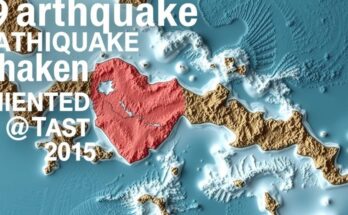On December 14, 2024, Cyclone Chido struck Mayotte with devastating winds of 225 kilometers per hour, causing extensive damage to infrastructure, especially in Mamoudzou. The storm, classified as a Category 4 cyclone, was the most powerful to hit Mayotte in over 90 years. Following its impact on Mayotte, Chido proceeded to Mozambique, highlighting the ongoing risks of severe weather in the region due to climate change.
On December 14, 2024, Cyclone Chido struck Mayotte with devastating force, displaying hurricane-strength winds that uprooted trees, damaged infrastructure, and caused significant destruction across the islands. Originating on December 5, 2024, in the southeastern Indian Ocean, Chido rapidly intensified, making landfall on Agaléga in Mauritius before it reached a peak intensity on December 12, sustaining winds up to 250 kilometers per hour, categorizing it as a powerful Category 4 hurricane. Following this trajectory, it passed just north of Madagascar and ultimately made landfall in northern Mayotte with winds recorded at 225 kilometers (140 miles) per hour, marking it as the strongest storm to impact Mayotte in over 90 years.
The cyclone left unprecedented damage in its wake, particularly in the capital city of Mamoudzou and the airport located on the island of Pamandzi. The European Union’s preliminary assessment based on satellite imagery highlighted the widespread destruction in both eastern and northern regions of Mayotte, with significant impacts noted in residential and transportation infrastructures. After wreaking havoc in Mayotte, Cyclone Chido continued its westward course towards Mozambique on December 15, maintaining its Category 4 cyclone status during subsequent landfalls.
This incident serves as a critical reminder of the vulnerability of island nations to severe weather events, particularly as cyclones intensify in response to changing climate conditions. Officials from Météo-France recognized this storm as a significant meteorological event in the region, emphasizing the need for robust disaster preparedness and response mechanisms to mitigate the effects of such natural disasters in the future.
Cyclone Chido represents a significant weather event that underscores the increasing frequency and intensity of tropical storms within the Indian Ocean region. With advancements in meteorological technology, the understanding of cyclones—particularly their formation, intensification, and impacts—has become increasingly sophisticated. The Saffir-Simpson wind scale categorizes cyclones based on sustained wind speeds, highlighting the potential for destruction, particularly in vulnerable territories like Mayotte, which lacks full infrastructure resilience against such natural disasters. As climate change continues to evolve, the likelihood of stronger storms necessitates enhanced preparedness and adaptation strategies for affected regions.
In summary, Cyclone Chido’s unprecedented impact on Mayotte exemplifies the devastating potential of modern cyclones and the urgent need for improved disaster readiness in island territories. The assessment of damage indicates a severe toll on both human life and infrastructure, accentuating the vulnerability of regions prone to such natural threats. The event serves to reinforce the significance of advancing mitigation initiatives and community resilience efforts in the face of climate change, which is anticipated to exacerbate such phenomena in the years ahead.
Original Source: earthobservatory.nasa.gov




